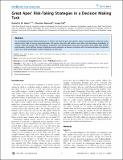Great apes' risk-taking strategies in a decision making task
Abstract
We investigate decision-making behaviour in all four non-human great ape species. Apes chose between a safe and a risky option across trials of varying expected values. All species chose the safe option more often with decreasing probability of success. While all species were risk-seeking, orangutans and chimpanzees chose the risky option more often than gorillas and bonobos. Hence all four species' preferences were ordered in a manner consistent with normative dictates of expected value, but varied predictably in their willingness to take risks.
Citation
Haun , D B M , Nawroth , C & Call , J 2011 , ' Great apes' risk-taking strategies in a decision making task ' , PLoS One , vol. 6 , no. 12 , 28801 . https://doi.org/10.1371/journal.pone.0028801
Publication
PLoS One
Status
Peer reviewed
ISSN
1932-6203Type
Journal article
Description
This research was funded by the Max Planck Society for the Advancement of Science. The funders had no role in study design, data collection and analysis, decision to publish, or preparation of the manuscript.Collections
Items in the St Andrews Research Repository are protected by copyright, with all rights reserved, unless otherwise indicated.

